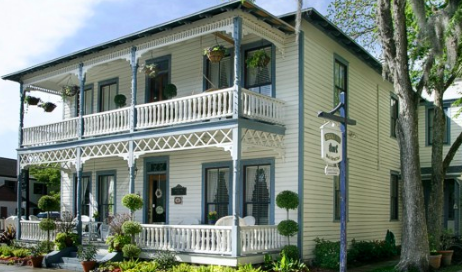St Augustine, Florida - America's Oldest City
Steeped in history with influences from Spain is an easy walking city with plenty to see.
My love of American history was piqued when reading about our nation’s oldest city, St. Augustine, Florida. I was a little skeptic of this label as I had visited the early settlements of Jamestown and Williamsburg and couldn’t imagine what could be older than those. On the northeastern coast of Florida, the city was founded in 1565 by Spanish explorers. It is the oldest “continuously inhabited” settlement within the border of the continental United States. The oldest city it turns out is San Juan, Puerto Rico. The town gets its name from St. Augustine whose feast day is August 28 around the time Spanish sailors landed their ships loaded with settlers, troops, and supplies from Spain on the beaches here.
The brightly painted ceiling sets off the wood beams with their intricate drawings.
St. Augustine is a walking city with a peaceful, welcoming vibe. One of the most impressive landmarks is the Cathedral Basilica of St. Augustine. The original church was constructed very quickly over five years to bolster the influence of the Spanish monarchy, The first known Christian congregation in the United States worshiped here as early as 1565. That structure burned at the hands of Sir Francis Drake and his troops and although reconstructed many times, fire and hostile take over wiped the church off the map for over 90 years before the present cathedral was built. Construction of the today’s Cathedral Basilica of St. Augustine was begun in 1793 and not completed in August 1797 combining Neoclassical and Spanish mission styles. Again, a fire ravaged the church but not entirely so through the years improvements were made to the building materials to stave off destruction from fire.
Most impressive to me was the exposed ceiling and tile floors. The colors are bright and vibrant - orange, yellow, brown, and green. The patterns are geometric pulling in interest but not taking away from the simplistic lines of the structure.
Spanish influence dominates the bright colors and patterns of the tile floors.
A great way to take in the history at a glance of St. Augustine is to book a seat on the hop-on-hop-off trolley. I was able to get the lay of the land and related history but could hop off when I wanted a closer look. Located in the center of the historic district is Flagler College, a private liberal arts college once the site of the famous Hotel Ponce de Leon founded by Henry Flagler. Flagler was the co-founder of Standard Oil along with John D. Rockefeller and is considered the “architect of the Florida Coast,” bringing the railroad to the state which helped boost the popularity of Miami and Palm Beach. The hotel was the first known fully electrified hotel in the US. Today, students enjoy dining in a room adorned with Tiffany stained glass windows and murals.
Next stop was the easy-to-navigate Lightner Museum. I was told I could breeze through in an hour and they were right. Housed in the former Alcazar Hotel, another Flagler project, was built in 1888 and was often called “the castle of happy returns.”
The hotel was a winter getaway for snowbirds during the winter, and some of its attractions included a casino, a grand ballroom, sulfur baths, steam rooms, a bowling alley and the world’s largest indoor swimming pool at the time. The hotel was at the peak of its popularity during the 1890s. Today, the museum houses exhibits of early St. Augustine heritage as well as other beautiful paintings and sculpture. The swimming pool is still intact, minus the water and serves as a restaurant and wedding venue.
The Lightner Museum is at the center of town with adjoining plaza. Found a great antique store here.
Lodging in St. Augustine is what you would expect from a historic beach town - plenty of affordable, centrally located hotels and many quaint B&Bs. I stayed at the Victorian House with comfortable rooms, beach close, and a perfect location for exploring on my own.
Lightner Museum Historic Pool
Once the nation’s largest indoor swimming pool, Cafe Alcazar now is a restaurant and wedding venue.






